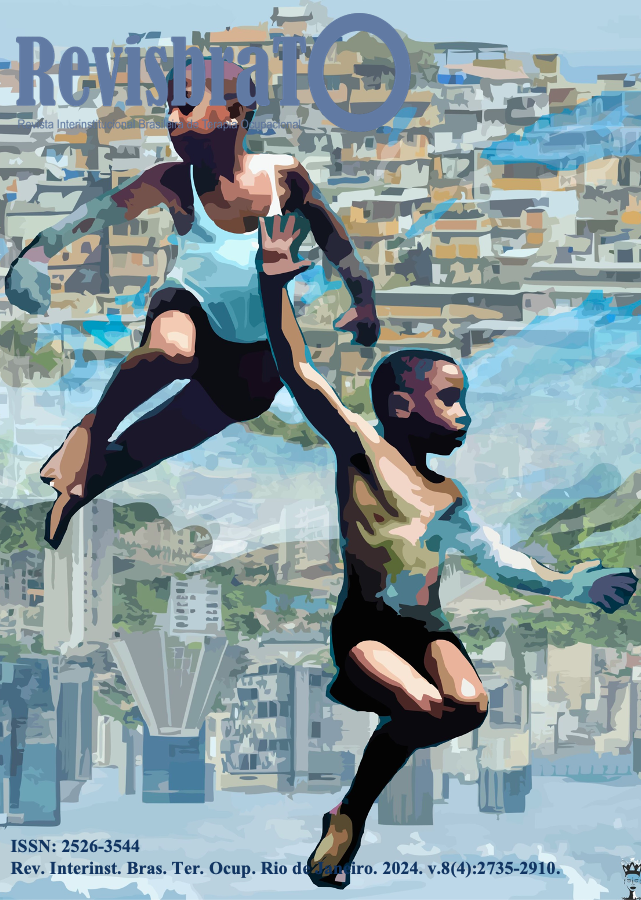CONTRIBUTION OF OCCUPATIONAL THERAPY IN PREVENTING PRESSURE INJURIES IN PRONED COVID-19 PATIENTS IN THE ICU: USE OF ASSISTIVE TECHNOLOGY
Contribution of occupational therapy in preventing pressure injuries in proned covid-19 patients in the ICU: use of assistive technology
DOI:
https://doi.org/10.47222/2526-3544.rbto62756Keywords:
Occupational Therapy, Prone Position, Self-Help Devices, Pressure Ulcer, COVID-19, Intensive Care UnitAbstract
Contextualization: Strategies created by Occupational Therapists (OTs) to reduce the risk of pressure injuries in critically ill patients with COVID-19 kept in the prone position for a long time. Intervention process: OT and multidisciplinary team developed the "Prone Kit", composed of orthotic devices with specific functions, to assist patients in the prone position, following stages of problematization, research, elaboration, testing, standardization and dissemination. Critical analysis practice: All prone patients in the ICU used the “Prona Kit" and none developed pressure injuries due to pronation. Team integration was essential for the quality of the final product and raising awareness among care professionals was one of the main challenges of the process implantation of the devices. Summary of considerations: The strategy was important to minimize injuries to prone patients and could be used in other necessary clinical conditions. The OT played an important role in aggregating the team and leading the project.
References
Coleman, S., Gorecki, C., Nelson, E. A., Closs, S. J., Defloor, T., Halfens, R., ... & Nixon, J. (2013). Patient risk factors for pressure ulcer development: systematic review. International journal of nursing studies, 50(7), 974-1003. https://doi.org/10.1016/j.ijnurstu.2012.11.019.
Carmo, G. P., et al. (2020). Intervenções terapêutico-ocupacionais para pacientes com COVID-19 na UTI. Revista Interinstitucional Brasileira de Terapia Ocupacional, 4(3), 397-415. https://doi.org/10.47222/2526-3544.rbto33997
Cazeiro, A. P. M.; Peres, P. T. (2010). A terapia ocupacional na prevenção e no tratamento de complicações decorrentes da imobilização no leito. Cadernos de Terapia Ocupacional, 18(2), 149–167. Disponivem em:https://www.cadernosdeto.ufscar.br/index.php/cadernos/article/view/351/282
De Carlo, M. M. R. P., et al. (2008). Terapia ocupacional e atenção ao paciente com dor não-oncológica. In De Carlo, M. M. R. P.; Queiroz, M. E. G. D. Dor e cuidados paliativos na perspectiva da Terapia Ocupacional, São Paulo: Rosa Ltda, p.167-190. Dis https://repositorio.usp.br/item/001688392.
Deshaies, L. D. (2005). Órteses de membro superior. In Trombly, C. A.; Radomsky, M. V.; Terapia ocupacional para disfunções físicas, 5 ed, Curitiba: Santos (pp. 351-370).
Guerin, C., Reignier, J., Richard, J. C., Beuret, P., Gacouin, A., Boulain, T., & Ayzac, L. (2013). Prone positioning in severe acute respiratory distress syndrome. New England Journal of Medicine, 368(23), 2159-2168.
Johnson, C., Giordano, NA, Patel, L., Book, KA, Mac, J., Viscomi, J., ... & Mastro, KA (2022). Pressure injury outcomes of a prone-positioning protocol in patients with COVID and ARDS. American Journal of Critical Care, 31 (1), 34-41. https://doi.org/10.4037/ajcc2022242
Kottner J, Cuddigan J, Carville K, Balzer K, Berlowitz D, Law S, Litchford M, Mitchell P, Moore Z, Pittman J, Sigaudo-Roussel D, Yee CY, Haesler E. Prevention and treatment of pressure ulcers/injuries: The protocol for the second update of the international Clinical Practice Guideline 2019. J Tissue Viability. 2019 May;28(2):51-58. doi: 10.1016/j.jtv.2019.01.001.
Lopes, J. M. A., et al. (2017). Lesões por pressão: desafios para a gestão hospitalar no Brasil. Revista de enfermagem UFPE on line, 11(9), 3669-3677. DOI: 10.5205/reuol.10601-94716-2-SM.1119sup201719.
Ministério da Saúde. (2013) Anexo 02: Protocolo para prevenção de úlcera por pressão. Ministério da Saúde/ Anvisa/ Fiocruz. Acesso em junho de 2023. In: https://www20.anvisa.gov.br/segurancadopaciente/index.php/publicacoes/item/ulcera-por-pressao.
Munshi, L., Del Sorbo, L., Adhikari, N. K. J., Hodgson, C. L., Wunsch, H., Meade, M. O., & Ferguson, N. D. (2017). Prone position for acute respiratory distress syndrome. A systematic review and meta-analysis. Annals of the American Thoracic Society, 14(Supplement 4), S280-S28
Nadeem, R., Chirayath-Wilson, N., D'souza, JP, Dsouza, FS, Thomas, BP, Mathew, M., ... & Tariq, R. (2023). Pressure injury incidence and impact on patients treated with prone positioning for COVID-19 ARDS. Journal of wound care , 32 (8), 500-506. https://doi.org/10.12968/jowc.2023.32.8.500
Paiva, K. C. A.; Beppu, O. S. (2005). Posição prona. Jornal Brasileiro de Pneumologia, 31(4), 332-40. https://doi.org/10.1590/S1806-37132005000400011
Shearer, SC, Parsa, KM, Newark, A., Peesay, T., Walsh, AR, Fernandez, S., ... & Pierce, ML (2021). Facial Pressure Injuries from Prone Positioning in the COVID-19 Era. 131 (7), E2139-E2142. https://doi.org/10.1002/lary.29374
Silva, T. B. et al. (2019). Terapia Ocupacional na unidade de terapia intensiva: uso de instrumentos de funcionalidade em pacientes críticos. Rev. Interinst. Bras. Ter. Ocup. Rio de Janeiro, 3(4), 478-493. DOI: https://doi.org/10.47222/2526-3544.rbto23420
Team V, Jones A, Weller CD. Prevention of Hospital-Acquired Pressure Injury in COVID-19 Patients in the Prone Position. Intensive Crit Care Nurs. 2022 Feb; 68:103142. doi: 10.1016/j.iccn.2021.103142.
Weinreich, M., Herman, J., Dickason, S., & Mayo, H. (2017). Occupational therapy in the intensive care unit: a systematic review. Occupational Therapy in Health Care, 31(3), 205-213. https://doi.org/10.1080/07380577.2017.1340690
Zhao, H. M., et al. (2020). Recommendations for respiratory rehabilitation in adults with COVID-19. Chin Med J. Epub ahead of print, 133(13), 1595-1602. DOI: 10.1097/CM9.0000000000000848
Downloads
Published
Issue
Section
License
Copyright (c) 2024 Revista Interinstitucional Brasileira de Terapia Ocupacional - REVISBRATO

This work is licensed under a Creative Commons Attribution-NonCommercial-NoDerivatives 4.0 International License.
Declaração e Transferência de Direitos Autorais
O periódico REVISBRATO -- Revista interinstitucional Brasileira de Terapia Ocupacional é publicado conforme o modelo de Acesso Aberto e optante dos termos da licença Creative Commons BY (esta licença permite a distribuição, remixe, adaptação e criação a partir da obra, mesmo para fins comerciais, desde que os devidos créditos sejam dados aos autores e autoras da obra, assim como da revista. Mais detalhes disponíveis no site http://creativecommons.org/licenses/by/3.0/).

No momento da submissão do manuscrito os autores deverão encaminhar, nos documentos suplementares a Declaração de responsabilidade, conflito de interesse e transferência de direitos autorais, segundo modelo disponivel na página "Instruções aos autores"
- Uso de imagens e discursos
Quando um autor submeter imagens para capa, que não correspondam a pesquisas em formato de artigo e que não tenham obrigatoriedade de autorização de Comitê de Ética, assim imagens presentes em outras seções, deverá ser anexado o TERMO DE CESSÃO DE DIREITO DE USO DA IMAGEM E DE DISCURSO (disponível modelo na página "Instruções aos autores"). Somente é necessário que o autor principal assine o termo e o descreva conforme o modelo abaixo em word.


